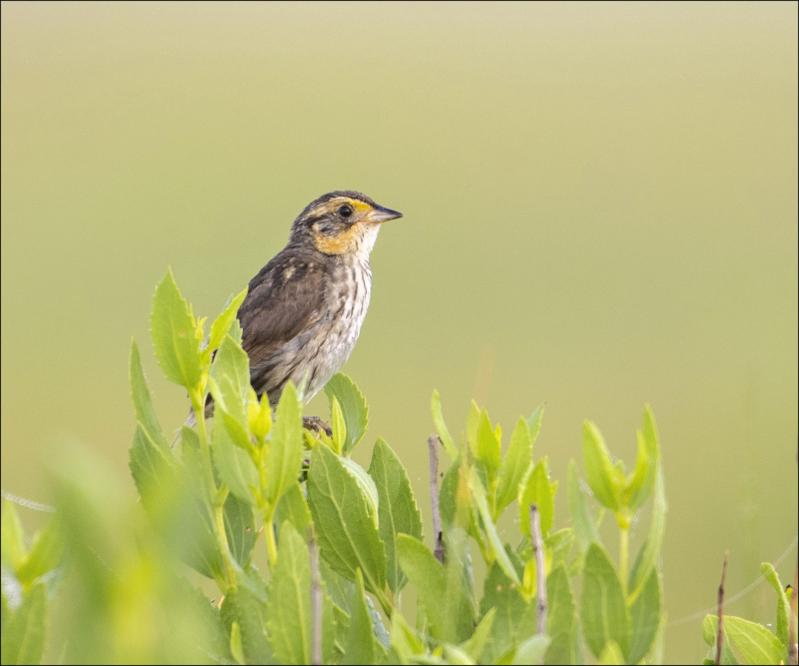As goes the little saltmarsh sparrow, so goes the salt marsh. In what could be a win for both, a team of scientists will now capture and band saltmarsh sparrows at Accabonac Harbor.
The East Hampton Town Board unanimously passed a resolution last week giving permission to Nicole Maher, a senior coastal scientist with the Nature Conservancy, to lead a team in its work on town-owned land at Accabonac Harbor, which could not only help the sparrows, but could also lead to a reduction in the amount of pesticide applied via helicopter to the marshes by Suffolk County Vector Control.
Dr. Maher has been banding the sparrows on land owned by the Nature Conservancy in the harbor for the past three years.
“Salt marshes are among the most productive and important habitats on the planet,” Brian Frank, the town’s assistant planning director, said as he introduced Dr. Maher. “They are up there with coral reefs and rain forests in terms of biodiversity, carbon sequestration, and nursery areas for important species of shellfish and finfish that we harvest indirectly. They support a myriad of other life species. They help buffer our shoreline from wave action and protect against erosion. They’re really a jewel.”
Sea level rise, however, is flooding the marshes. The saltmarsh sparrow cannot breed in marshes that are continually flooded, and thus they act as a key indicator of marsh health.
Dr. Maher has been measuring how Accabonac Harbor is keeping up with sea level rise since 2008. “The news there is it’s not keeping up,” she told the board. “But we have the opportunity to switch that elevation trajectory from negative to positive because we’ve learned it’s related to the way the plants are growing. Fixing the hydrology, fixing the way water comes into and out of the harbor, and the growing conditions for the plants can really set this jewel of Accabonac Harbor on the right trajectory for the future.”
Ancient agricultural features dating back to the 1600s, which once helped the early settlers raise cattle and farm, are having a negative impact on marsh health. “The first time that people manipulated the way water moved into and out of our salt marshes was not when the linear mosquito ditches were dug,” she told the board.
In other words, for hundreds of years, remnant manipulations from colonial farmers have affected the way water flows in the marsh.
“We are working to develop ‘light touch’ restoration approaches for all of the publicly accessible portions of Accabonac Harbor,” Dr. Maher said, part of which includes filling in the old mosquito ditches and agricultural embankments. Doing so will allow the water to flow better.
“One character who really depends on us getting this right is the saltmarsh sparrow,” which has adapted to life in the marsh as a way of avoiding predators. The bird needs only 23 days to lay a clutch of eggs, hatch them, and fledge the chicks.
They build and attach their cup-shaped nests near the base of grasses in the intertidal zone, and their eggs can withstand immersion in salt water. “So long as the tide doesn’t come up so high that it pushes the eggs up over the cup of the nest,” Dr. Maher said, which would cause them to float away. “Things are getting harder for the birds. Their populations are declining across their entire range.”
These are purely American birds, she explained. They exist only from Maine to Florida. East Hampton is lucky to have a breeding population, which Dr. Maher has proven with her past banding operations.
“Their chicks, their eggs are getting flooded because the marsh isn’t keeping up with sea level rise. The solution is making sure the plants in our marshes are growing really well so they can put out lots of roots and rhizomes below ground, trap sediments, and keep up with sea level rise. If our marshes are healthy, the birds will be successful.”
Part of that is restoring the marsh. It could be as easy as raking some marsh grass into the mosquito ditches at the end of the growing season and then holding it down with twine and stakes.
“As the tide comes in and goes out, that network of grasses from last year is trapping sediments and helping those ditches repair themselves from the bottom up by regrowing marsh peat and soils,” she said. “By forcing all of the energy of the tide through fewer channels, it keeps the sediments in suspension in the water as the tide comes in and helps deposit those sediments on the surface of the marsh.”
Councilman Ian Calder-Piedmonte said that while he passed the salt marshes daily, he didn’t realize until recently how little he knew about them. “I knew that they were important natural habitat and natural resources, but I didn’t quite understand the extent of it. And to hear you compare it to rain forests, I just didn’t realize that there was so much there. What excites me most about this project is I think it’s something that through small changes we can achieve real impact.”
“Some of the scariest things you see down there is if you’re with your kids when the helicopter comes over top with spray,” Councilman David Lys said. “It’s loud. It’s close. It’s frightening. So, if this is a step that we can get to decreasing that, or removing that, I’m completely supportive.”
“I’m optimistic that with these light touches, we’ll be able to help the marshes keep up with sea level rise, support the birds, and do everything else we want the marshes to do for us,” Dr. Maher said.
“Thank you so much for the optimism,” Councilwoman Cate Rogers said. “There’s nothing better than that.”




